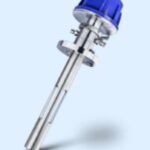
Whether living in lunar habitats or space ships, human explorers and colonists face a common challenge: maintaining air quality in a confined space. On Earth gases emanating from respiration (carbon dioxide), combustion, or even everyday tasks such as cooking and brewing coffee are allowed to disperse into the atmosphere where they will be diluted. But habitats in space must maintain an early warning detection system to alert occupants before gases build to dangerous levels.
Existing residential and commercial fire detectors are useless, say the authors of a paper in New Space, “Multispecies Single Light-Emitting Diode Mid-Infrared Gas Sensor for Space Habitats and Vehicles.”
Spacecraft cabins gas sensors in operation on the Skylab and International Space Station use laser-based absorption spectroscopy. However, they are expensive, they’re sensitive, and they consumer a lot of power. The authors recommend the use of light-emitting diodes (LEDs), which feature lower power requirements and can be implemented in a broad range of sensors.
